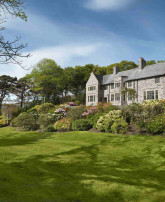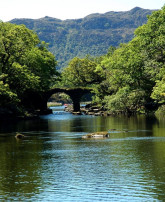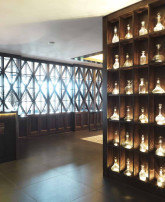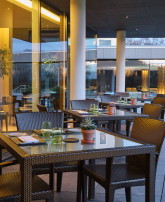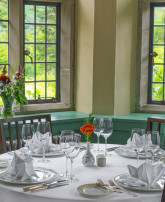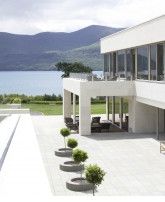
Exploring the Enchanting Flora and Fauna of the Ring of Kerry
Posted: 19 February 2024
The Ring of Kerry, a scenic jewel adorning Ireland's southwest coast, beckons travellers with its breathtaking landscapes. But beyond the dramatic cliffs and charming villages lies a hidden world teeming with unique and diverse flora and fauna. While many visitors come to marvel at its stunning vistas and ancient ruins, the region is renowned for its vibrant landscapes, rugged coastline, and rich cultural heritage. The region's remoteness from the rapid urbanization that transformed much of Europe from rural to urban civilization has conserved both a traditional way of life and exceptional wildlife habitats. The Ring encompasses a diverse range of terrains, including the renowned mountains and lakes of Kerry, expansive farmland, rugged heath and moorlands, ancient woodlands, and some of Europe's most stunning coastline. It harbours a vast array of wildlife species.
The Wonders of the Killarney National Park
Killarney National Park, a gem nestled in the heart of County Kerry, is the country’s oldest national park and sits on what was the Muckross Estate, which was donated to the nation in 1932. Spread across 25,000 acres of breathtaking landscapes, this enchanting park beckons travellers with its pristine beauty, rich history, and abundant wildlife. It's a place to reconnect with nature, lose yourself in adventure, and create memories that will last a lifetime. Wander through the opulent Muckross House, a Victorian mansion frozen in time with its grand interiors and manicured gardens. Explore Ross Castle, a 15th-century fortress guarding the shores of Lough Leane, and let your imagination run wild with tales of knights and battles. Journey to Inisfallen Island, where monks once penned ancient manuscripts, and feel the weight of history beneath your feet. For those seeking adventure, Killarney National Park offers a wealth of outdoor activities to suit every interest and skill level. Hike to the summit of Torc Mountain for panoramic views of the surrounding landscape, paddle across the glassy waters of the Lakes of Killarney in a traditional rowboat, or saddle up for a horseback ride through the park's scenic trails. With so much to see and do, the possibilities are endless.
The Plant Kingdom of the Ring of Kerry
Step into a realm where temperate wonders mingle with Mediterranean surprises. Descend into Killarney National Park, a haven for rare finds. Witness the ancient magic of the remaining yew woods in Europe, wander through the last fragments of Ireland's oakwoods, and be captivated by the Emerald fern, exclusive to this haven. The mild climate allows even North American visitors like the Pipewort and Blue-eyed Grass to flourish, creating a truly international botanical tapestry.
One of the most iconic sights along the Ring of Kerry is the vast swathes of purple heather and vibrant yellow gorse that blanket the hillsides. These hardy plants thrive in the acidic soils and cool, moist climate of the region, providing essential habitat and food sources for local wildlife. The Greater Butterwort, known colloquially as the Kerry Violet, thrives in the bog lands, where it captures and digests insects unlucky enough to fall into its clutches.
Inland, the landscape gives way to lush woodlands dominated by native species such as oak and ash. These ancient forests are home to a wealth of plant life, including ferns, mosses, and lichens, which thrive in the damp, shady conditions beneath the canopy. The Killarney fern (Trichomanes speciosum) is exclusive to the park, adding to its allure. Its captivating beauty, often thriving in the misty environment beneath waterfalls, contributes to its rarity. Previously, tourists frequently purchased it as a memento of their journey around the Ring of Kerry.
Throughout the spring and summer months, the roadside verges and meadows of the Ring of Kerry burst into colour with an abundance of wildflowers. From delicate bluebells and buttercups to bold foxgloves and fuchsia, these blooms attract a myriad of insects and birds, contributing to the region's biodiversity. The Killarney Whitebeam stands out as another local gem, deriving its name from the striking white shimmer revealed when its leaves are flipped by the wind.
Along the rugged coastline, hardy maritime plants cling to the cliffs and rocky shores, braving the salty spray and fierce winds. Sea thrift, sea campion, and samphire are just a few examples of the resilient species that have adapted to thrive in this harsh coastal environment. Irish spurge, another distinctive plant found in the region, holds a significant place in folklore. Its sap, once believed to possess wart-healing properties, was also a handy tool for fishermen as it could poison fish by interfering with their gills, rendering them unable to breathe.
Bird-watching Paradise of the Killarney National Park
The woodlands of Killarney is a haven for avian enthusiasts, with a diverse array of bird species calling the park home. From native birds such as robins, blue tits, and chaffinches flitting among the branches, you might even spot a shy woodpecker or a majestic bird of prey soaring overhead. The area boasts a diverse array of wildlife, with 141 species documented within its boundaries. Among these are the energetic Blue Tit, the vibrant Chaffinch with its red underbelly and blue cap, and the diminutive Goldcrest, nicknamed the 'King of the Birds' due to its crown-like yellow head markings. Red-breasted robins and tiny Wrens can also be spotted feeding among the oak trees.
On higher ground, Meadow Pipits, Stonechats, and Ravens are commonly sighted. However, avid birdwatchers may have their sights set on more elusive species such as the Redstart, Wood Warbler, Garden Warbler, Red Grouse, and Ring Ouzel. The area is also the only known habitat in the British Isles where one can spot the Chough, a black-plumaged relative of the Jackdaw with strikingly coloured legs.
Merlins and Peregrine Falcons hunt and breed within the park, while Ospreys and Golden Eagles, although once residents, may still occasionally pass through during migration. White-tailed Eagles were introduced to the park starting in 2007, though not all have remained in the area.
During the summer months, Swallows, Swifts, and Cuckoos make their presence known. Around the lakes, visitors can observe Little Grebes, Mallards, Dippers, Water Rails, the dazzling blue flash of Kingfishers, and majestic Herons.
In winter, the lakes, particularly Lough Leane, become vital resting places for migrating birds, including Fieldfares, Redwings, and various wildfowl such as Wigeon, Pochard, Whooper Swans, Teal, Coot, Tufted Ducks, Cormorants, and Goldeneyes. The rare Greenland white-fronted geese are among the notable visitors to the area. Birdwatchers flock to spots like Skellig Michael to catch a glimpse of nesting seabirds, including puffins and gannets.
The Animal Diversity of Kerry’s Woodland
The Ring of Kerry isn't just a feast for the eyes; it's a serenade for the ears too. Undoubtedly, the highlights of Killarney National Park are the native, wild Red Deer—the only species of their kind in Ireland. Approximately 700 of these magnificent creatures roam the park, typically favouring the higher elevations. In the remote upland areas of the Ring of Kerry, herds of red deer roam freely, their russet coats blending seamlessly with the autumnal hues of the landscape. These elusive creatures are a rare sight but are a treasured symbol of the region's wilderness. The park also hosts glimpses of the majestic Sika deer, introduced centuries ago and now thriving in this unique ecosystem.
In the open moorlands and grassy plains of the interior, the Irish hare is a common sight, its long ears twitching as it darts across the landscape. These fleet-footed creatures are an integral part of the local ecosystem, playing a vital role in controlling plant populations and providing food for predators.
Bats flit through the twilight, while the elusive Kerry slug, capable of rolling into a perfect ball, emerges from its daytime hideaway. Keep your eyes peeled for the vibrant flash of the Purple Hairstreak butterfly, showcasing its wings amongst the oak leaves. Even the waters teem with life, with the Northern Emerald dragonfly, exclusive to the park, gracefully skimming the surface.
The Park is also home to the elusive Bank Vole, a native species that is rarely encountered. Resembling a small mouse, these creatures are an unintentional introduction and are adept at remaining hidden, typically residing in burrows lined with leaves.
Another resident of the park is the Pine Marten, a cousin of the badger, known for its predatory nature towards Bank Voles. These martens possess a distinctive flash of yellow fur on their throats and are approximately the size of a large cat.
If you have an interest in slugs, keep an eye out for the Kerry Slug during wet weather. Reportedly, it is the sole slug species capable of rolling into a ball.
The waters surrounding the Ring of Kerry team with marine life, from playful Grey Seals and otters to majestic basking sharks, minke whales, beaked whales and even leatherback turtles and elusive dolphins.
Conservation Efforts
While the Ring of Kerry is blessed with an abundance of natural beauty, it is not without its challenges. Climate change, habitat loss, and invasive species pose significant threats to the delicate balance of its ecosystems. Fortunately, a number of conservation organizations and initiatives are working tirelessly to protect and preserve the flora and fauna of the region for future generations to enjoy. Through sustainable land management practices, habitat restoration projects, and public education efforts, these groups are helping to safeguard the biodiversity of the Ring of Kerry and ensure that its natural treasures remain intact for years to come.
The Ring of Kerry is not only a feast for the eyes but also a haven for biodiversity, boasting a rich tapestry of flora and fauna that reflects the unique character of this stunning corner of Ireland. From the windswept cliffs and heather-clad hillsides to the tranquil woodlands and sparkling seas, every corner of the region is teeming with life, waiting to be discovered and cherished by those who venture along its winding roads. Respecting this delicate ecosystem is crucial. Admire the flora and fauna from a distance, avoid disturbing their habitats, and dispose of waste responsibly. So, lace up your walking boots, pack your binoculars, and embark on a journey to discover the hidden gems of the Ring of Kerry. The stunning landscapes are only the beginning; a world of fascinating flora and fauna awaits, promising an unforgettable encounter with the magic of the Emerald Isle. Book yourself up at The Dunloe Hotel and Garden to relax after witnessing the beauty of the flora and fauna of Kerry.



